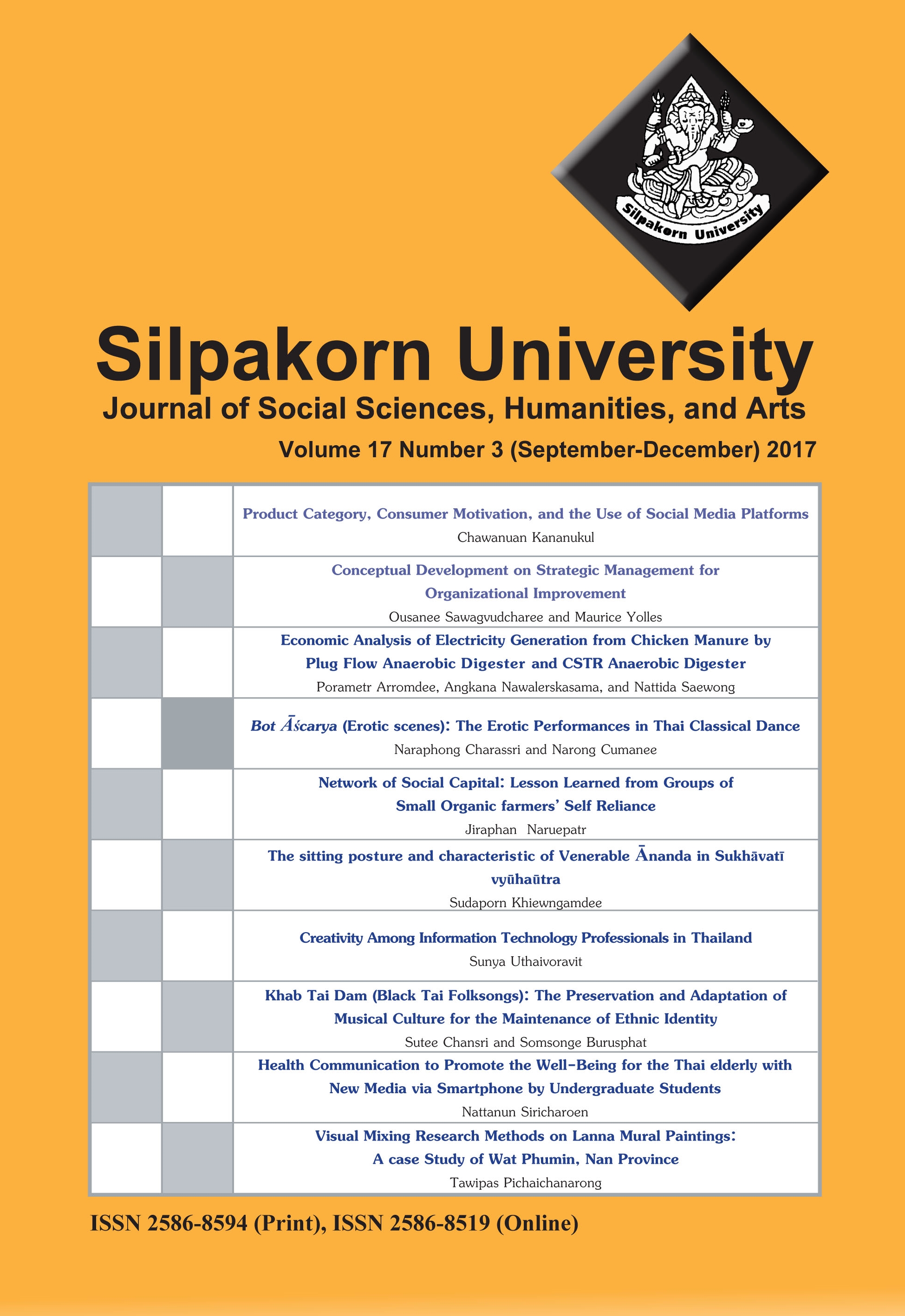Khab Tai Dam (Black Tai Folksongs): The Preservation and Adaptation of Musical Culture for the Maintenance of Ethnic Identity
Main Article Content
Abstract
This article aims to describe the identity maintenance of the Tai Dam ethnic group through an analysis of musical components of Khab Tai Dam which was a cultural symbol that changed in accordance with the social context. The case study was mainly of Tai Dam people living in Laos, Vietnam and Thailand.
The study result found that Khab Tai Dam serves two functions; it is sung at ritual ceremonies and for entertainment culture. The first function is tied to the Tai Dam belief that the singer must learn and strictly follow the traditional practice of Khab Tai Dam as it has been preserved by their ancestors and transmitted from one generation to another. The second function involves an adaptation of Khab Tai Dam by blending the traditional rhythm and content with the rhythmic patterns of modern musical instruments such as the electone in order to appeal to a wider audience, especially Tai Dam teenagers.
In all three countries, both functions were found but Khab Tai Dam’s roles have diminished. In Thailand, the ethnic musical components or patterns of singing have been maintained. However, the role of Khab Tai Dam has changed to become a cultural demonstration of ethnic cultural preservation at the annual festival held in Tai Dam communities. In Vietnam, the singing has also been maintained but new technology in the form of karaoke DVDs is used to promote Khab Tai Dam. Music videos portraying various aspects of ethnic life have been produced. In Laos, the Lam Phloen rhythm, which is a part of mainstream Lao musical culture, has been incorporated into the traditional patterns and an electronic organ has replaced traditional instruments like gongs. The diminished roles of Khab Tai Dam in the three countries reflects the fact that traditional Khab Tai Dam is rarely being transmitted down to qualified successors. Without a willing new generation to take over the art, traditional Khab Tai Dam no longer functions as a cultural symbol. On the other hand, modern Khab Tai Dam, which has been changed and adapted for learning and succession purposes, has retained the typical features of Tai Dam music whilst also blending in modern music. Consequently, modern Khab Tai Dam is able to continue to express Tai Dam identity within the dynamic societies of the three countries.
Downloads
Article Details
All rights reserved. Apart from citations for the purposes of research, private study, or criticism and review,no part of this publication may be reproduced, stored or transmitted in any other form without prior written permission by the publisher.
References
Merriam, A. P. (2002) The Anthropology of Music. Translated by Bussakorn Samrongthong. Bangkok: Thailand Research Fund.
Barth, F. (1969) Pathan identity and its maintenance. In Ethnic Groups and Boundaries: The Social Organization of Culture Difference (Fredrik Barth et al., eds), pp. 117-134. Boston: Little, Brown and Company.
Buadaeng, K. (2003). A change of religion: A complexity of Karen identity expression in northern Thailand (“การเปลี่ยนศาสนา: ความซับซ้อนของการ แสดงตัวตนของคนกะเหรี่ยงทางภาคเหนือของประเทศไทย”). In Identity, Ethnicity and Maginalisation (“อัตลักษณ์ ชาติพันธุ์ และความเป็นชายขอบ”), (Pinkaew Laungaramsri, ed), pp.173-201. Bangkok: Princess Maha Chakri Sirindhorn Anthropology Centre.
Hongsuwan, P. (2004) Legends and ritual of city ghost worship: Creating awareness of Tai Puan and Phu Tai history in Thailand (“ตำนานและ พิธีกรรมบูชาผีเมือง: การสร้างสำนึกทางประวัติศาสตร์ของไทพวนและผู้ไท”) In Thainess (“ความเป็นไทย”), pp. 56-93. Bangkok: Princess Maha Chakri Sirindhorn Anthropology Centre.
Kanjanaphan, A. (2005) Fighting for humanness of marginal people in Thai society (“การต่อสู้เพื่อความเป็นคนของคนชายขอบในสังคมไทย”). In Being Marginal: See Through Knowledge (“อยุ่ชายขอบ มองลอดความรู้”), pp. 3-31. Bangkok: Matichon Publishing House.
Luangaramsri, P. (2003) Identity, Ethnicity, and Marginalization (“อัตลักษณ์ ชาติพันธุ์ และความเป็นชายขอบ”). Bangkok: Princess Maha Chakri Sirindhorn Anthropology Centre.
Prajuabmoh, C. (2004) A review of approaches to diachronic studies of ethnicity and education in Thai society (“ทบทวนแนวทางการศึกษาชาติพันธุ์ข้าม ยุคสมัยกับการศึกษาในสังคมไทย”). In Approaches to Ethnic Studies (“ว่าด้วยแนวทางการศึกษาชาติพันธุ์”), pp. 14-20. Bangkok: Princess Maha Chakri Sirindhorn Anthropology Centre.
Pitiphat, S. (2000) Tai People of Muang Kwa: Tai Taeng and Tai Muang in Vietnam (“คนไทเมืองกว่า : ไทแถงและไทเมืองในประเทศเวียดนาม”). Thai Khadi Research Institute, Thammasat University.
Raengphet, A. (2002) Mai Maen Flute Ensemble: Music in Ancestor Worship Ritual of Lao Song in Khaw Yoi District, Phetchaburi Province “วงปี่ ไม้แมน : ดนตรีในพิธีเสนของชาวลาวโซ่ง ในอำเภอเขาย้อย จังหวัดเพชรบุรี”).Faculty of Liberal Arts, Mahidol University.
Saiphan, P. (2004) Trans-ethnicity in northwest Vietnam (“การแปลงผ่านอัตลักษณ์ ชาติพันธุ์ในภาคตะวันออกเฉียงเหนือของเวียดนาม”). In Thainess (“ความเป็นไทย”), pp.96-132. Bangkok: Princess Maha Chakri Sirindhorn Anthropology Centre.
Wongthes, S. (2010) Where did Thai Music come from? (“ดนตรีไทยมาจากไหน?”). Nakhornpathom: College of Music, Mahidol University.

